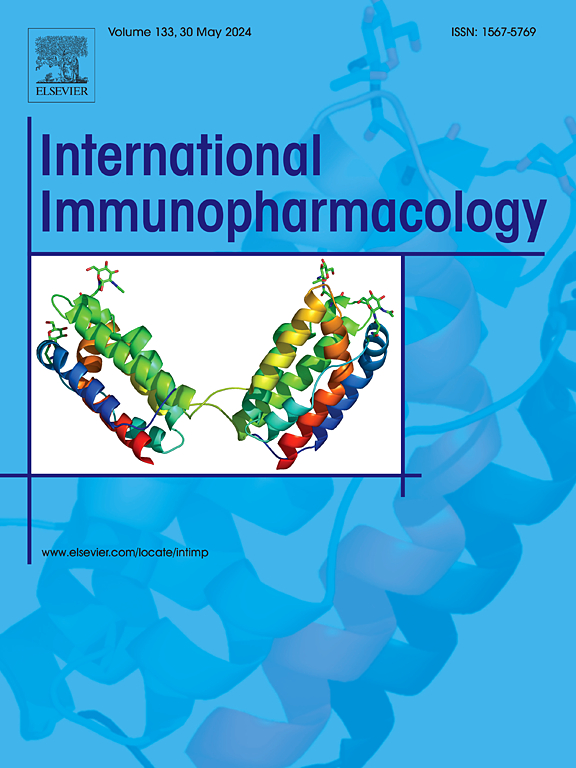ADAM17敲低比AT1R阻滞剂更能通过下调RhoA-ROCK1通路缓解糖尿病性心肌病
IF 4.7
2区 医学
Q2 IMMUNOLOGY
引用次数: 0
摘要
糖尿病性心肌病(DCM)是糖尿病的严重并发症,导致死亡率增加。a -解体素和金属蛋白酶17 (ADAM17)是肾素-血管紧张素-醛固酮系统(RAAS)的一个新成员,已被证明对心脏纤维化具有保护作用,但确切的分子机制尚不清楚。本研究旨在阐明ADAM17在DCM发病机制中的作用及其与RhoA/ROCK1信号通路的相互作用,重点关注心脏成纤维细胞向肌成纤维细胞转化和心脏重塑。我们利用aav9介导的基因沉默来研究ADAM17沉默对糖尿病小鼠心功能和纤维化的影响,以及它相对于传统的氯沙坦(一种选择性血管紧张素II型1受体(AT1R)拮抗剂)的优势。结果表明,ADAM17沉默显著降低胶原沉积和促纤维化蛋白水平。ADAM17敲除或氯沙坦治疗均可减少RhoA/ROCK1信号通路的激活。高糖诱导肌成纤维细胞分化,两种处理均可抑制。值得注意的是,ADAM17的下调在改善心功能和减少纤维化方面比氯沙坦更有效,但两者没有协同作用。综上所述,靶向ADAM17和RhoA/ROCK1是一种很有前景的治疗DCM的治疗策略,可以改善患者的预后。本文章由计算机程序翻译,如有差异,请以英文原文为准。

ADAM17 knockdown is more effective than AT1R blocker in alleviating diabetic cardiomyopathy through downregulating the RhoA-ROCK1 pathway
Diabetic cardiomyopathy (DCM) is a serious complication of diabetes that contributes to increased mortality. A-disintegrin and metalloproteinase 17 (ADAM17), a novel member of the renin-angiotensin-aldosterone system (RAAS), has been shown to exert a protective effect against cardiac fibrosis, but the exact molecular mechanisms remain unclear. This study aims to elucidate the role of ADAM17 in the pathogenesis of DCM and its interaction with the RhoA/ROCK1 signaling pathway, focusing on cardiac fibroblast-to-myofibroblast transition and cardiac remodeling. AAV9-mediated gene silencing was used to investigate the effect of ADAM17 silencing on cardiac function and fibrosis in diabetic mice and its advantage over conventional losartan, a selective angiotensin II type 1 receptor (AT1R) antagonist. The results showed that ADAM17 silencing significantly reduced collagen deposition and pro-fibrotic protein levels. Either ADAM17 knockdown or losartan treatment resulted in less activation of the RhoA/ROCK1 signaling pathway. High glucose induced myofibroblast differentiation, which was inhibited by either treatment. Notably, knockdown of ADAM17 was more effective than losartan in improving cardiac function and reducing fibrosis, but they had no synergistic effect. In conclusion, targeting ADAM17 and RhoA/ROCK1 is a promising therapeutic strategy for the treatment of DCM to improve patient outcomes.
求助全文
通过发布文献求助,成功后即可免费获取论文全文。
去求助
来源期刊
CiteScore
8.40
自引率
3.60%
发文量
935
审稿时长
53 days
期刊介绍:
International Immunopharmacology is the primary vehicle for the publication of original research papers pertinent to the overlapping areas of immunology, pharmacology, cytokine biology, immunotherapy, immunopathology and immunotoxicology. Review articles that encompass these subjects are also welcome.
The subject material appropriate for submission includes:
• Clinical studies employing immunotherapy of any type including the use of: bacterial and chemical agents; thymic hormones, interferon, lymphokines, etc., in transplantation and diseases such as cancer, immunodeficiency, chronic infection and allergic, inflammatory or autoimmune disorders.
• Studies on the mechanisms of action of these agents for specific parameters of immune competence as well as the overall clinical state.
• Pre-clinical animal studies and in vitro studies on mechanisms of action with immunopotentiators, immunomodulators, immunoadjuvants and other pharmacological agents active on cells participating in immune or allergic responses.
• Pharmacological compounds, microbial products and toxicological agents that affect the lymphoid system, and their mechanisms of action.
• Agents that activate genes or modify transcription and translation within the immune response.
• Substances activated, generated, or released through immunologic or related pathways that are pharmacologically active.
• Production, function and regulation of cytokines and their receptors.
• Classical pharmacological studies on the effects of chemokines and bioactive factors released during immunological reactions.

 求助内容:
求助内容: 应助结果提醒方式:
应助结果提醒方式:


